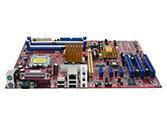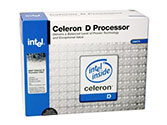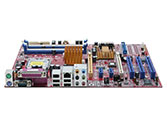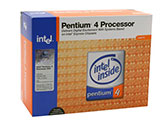Entry Level Buyer’s Guide, July 2005
by Jarred Walton on July 20, 2005 12:05 AM EST- Posted in
- Guides
Intel Recommendations
Not a whole lot has changed in the budget Intel market. Intel has had PCIe graphics for a while now, and we're still waiting for newer Celeron and Pentium chips with 64-bit support. (We're also waiting for Semprons with 64-bit support, though really we're not too concerned about the 64-bit factor for budget systems.)  |
 |
| Click images to enlarge. | |
Budget 775 Motherboard: Biostar I915P-A7
Price: $79 shipped
Budget 775 CPU: Intel Celeron D 330J 2.66GHz 256K L2 (Retail)
Price: $85 shipped (Retail)
Total: $164
Almost exactly matching the budget AMD setup in price, we continue with similar recommendations to our last budget Guide. The choice of CPU is less about performance than price, but the difference between the 2.53 GHz 325 and the 2.66 GHz 330J is only $4, so we go with the upgraded processor. You can see the complete list of Celeron prices on our Price Engine, and the next model up from the 330J adds $15, which is more than we're willing to pay for a budget setup.
The motherboard choice is the cheapest 775 motherboard that we could find with a few qualifications. First, it needs to be a PCI Express board, which generally means the 915P or 915G chipset. We avoid the 915GV chipset as that reduces performance by only supporting single-channel memory. The other requirement is that the board needs to have 4 DIMM slots of the same type, and for now, that means DDR. Some people may not mind the hybrid boards, but we like to have the ability to run 4x512MB of RAM in the future. The Biostar I915P-A7 fits all of those requirements and comes in substantially cheaper than most other competitors. Biostar also offers the I915G-M7 for those who want integrated graphics - as a business solution or a standby until you can add in a decent graphics card, the extra $6 is a good deal.
The only other boards that are priced similarly are from Jetway (915PCP/GCP), ECS (915G-M), Foxconn (915G7MC-S), and Aopen (i915Pa-E) - we may have missed one or two boards, but the point is that there aren't any name brands like ASUS or MSI in this price range. None of these are really better than the Biostar in our opinion, and they all cost a bit more.
If you like the idea of integrated graphics but want more performance, the ASUS P5RD1-V uses the ATI Xpress 200 chipset and may be worth consideration. The price of $100 makes it a moderately expensive upgrade, and if you're looking at an IGP solution you probably don't care much that the Xpress 200 is twice as fast in several gaming benchmarks - a discrete graphics card will still outperform the IGP with relative ease. As with the MSI Xpress 200 board for AMD, we don't expect much in the way of overclocking due to the chipset. Overclockers should probably look to the more recognized enthusiast brands like ASUS, DFI, MSI, etc. and get an Intel chipset, though you'll also have to pay over $100 for those.
 |
 |
| Click images to enlarge. | |
Upgraded 775 Motherboard: Biostar I945P-A7
Price: $98 shipped
Upgraded 775 CPU: Intel Pentium 505 533 FSB (Retail)
Price: $134 shipped (Retail)
Total: $232
Our upgraded Intel platform takes a bit different approach than the past. Price is once again equal to the AMD side of things, but we spend more on the motherboard and less on the CPU. We cut the CPU from the Pentium 520 of previous Guides (2.8 GHz 800FSB with HyperThreading) to the 505 (2.66 GHz 533FSB and no HyperThreading). HTT is sort of interesting, but the extra $40 to upgrade to the 520 is pretty significant. Actually, the 530J is only a couple of dollars more than the 520, so if you do go for the faster processor, the 530J is the better buy. Performance of the 505 is reasonable, though clearly outclassed by the Athlon 64 processors. Part of the reason why we like the 505 is that you can get some great overclocking results from it on virtually any motherboard. The processor has a 20X multiplier, so combined with a bus speed of 166 to 200, you can shoot for 3.33 GHz to 4.0 GHz. The upper end of that range may be difficult to reach, but 3.4 to 3.6 GHz is pretty reasonable for the 90nm Prescott design.
Along with the switch to a slightly slower CPU, we've included the cheapest DDR2 board that we could find for future compatibility, and it also uses the new 945P chipset. The switch to DDR2 will increase the price slightly relative to DDR, but even AMD will be moving to DDR2 early next year, so you should be able to use the RAM in a future system. Integrated graphics versions of the chipset are also available with the 945G series, with the most affordable options coming from ASUS (P5LD2-VM) and Intel themselves. The cheapest 945G models are micro ATX form factors, allowing the use of a smaller case like the Aspire X- QPack that we recently reviewed, as well as any other uATX case. (You can always put the small motherboard in a full-size ATX case if you prefer.)
The 945 chipsets all support dual core CPUs, providing another future upgrade path. With the cheapest Pentium D starting at well over $200, we can't recommend such a CPU for a budget system yet, but we expect prices to drop over the coming year, making it a viable upgrade in 2006. If you go with the budget Intel recommendation, you're stuck with single core processor support for as long as you own the system. Of course, some people never upgrade individual components and prefer to replace the entire system every few years. If that describes your purchasing habits, there's not much point in buying more future-proof components.










57 Comments
View All Comments
wilburpan - Wednesday, July 20, 2005 - link
Regarding Dell: before I read the comments I went over to the Dell website and looked over their current offerings. There are cost cutting measures on the part of Dell to bring the price down on their budget systems: PATA instead of SATA, questionable memory, lack of PCIe, their Celeron based systems come with a maximum of 512 MB RAM, and probaby a bunch more that I don't know about.About this buying guide: some of the recommendations take into account future upgradability. I'm not sure that this should be a real priority for a budget system. One thing that has been made clear to me over the past few years is that building a computer is an exercise in balancing all the components. As a result, once a computer gets very old, it is more cost effective to replace the whole thing rather than upgrading a component at a time. Being that this is a budget system, the lifetime of the components would be less than average, as these components have already been on the market for a while.
bob661 - Wednesday, July 20, 2005 - link
Jarred,In the article you mention that you can do 222 with the OCZ Gold at 2.8V but on OCZ's website it says 3.2V. Can you clarify this?
Zoomer - Wednesday, July 20, 2005 - link
What about motherboards based on the RS482?They offer decent integrated graphics at a good price.
http://www.msi.com.tw/program/products/mainboard/m...
xsilver - Wednesday, July 20, 2005 - link
#12gigabyte makes a fanless 6600GT
costs a few dollars more but if you need it
bupkus - Wednesday, July 20, 2005 - link
I just built a system with an OEM 3000+ Venice for $115, Epox 9NPA+ Ultra for #105 and a Gigabyte X300 for about $70 and now I hear the X700 is the way to go for just a little more. I like to play Ut2004 and that's it. Hmm.. time to rma the X300 and get that X700 before it's too late.I'd consider the 6600GT but I dont' want noisy and I get that impression.
JarredWalton - Wednesday, July 20, 2005 - link
Bah - I caved and listed an optional PSU. I still feel like I keep repeating myself from Guide to Guide, but maybe you readers don't notice it as much? :)10 - PATA is going to be a bit slower and we don't really like the cables. The newer Intel motherboards often come with a single PATA connection (supporting two drives), making it a very poor choice for such motherboards. It *is* an option, but there's a reason PATA drives are getting large mail-in rebates. The same reason such drives often end up in OEM systems: the manufacturers are clearing out old inventory.
Anyway, I don't generally worry much about the mail-in rebate opportunities, as it's basically loaning a company your money at 0% interest for several months. If you can find a good rebate on an SATA drive, I'd prefer that personally, but PATA drives are still okay for some people.
Hacp - Wednesday, July 20, 2005 - link
One question I had was why SATAII? Why not a 40 dollar 80GB PATA100 HD from circuit city or best buy after rebates? I know that those two stores are good for their rebates, and with the 15 dollars you save, you can defenetly upgrade the processor, which is a better bang for your buck in terms of performance.JarredWalton - Wednesday, July 20, 2005 - link
Regarding case and PSU: yes, I realize the PSU is suspect, and I always put better PSUs in computers I build. However, I've also used generic PSUs in budget PCs, and provided the systems aren't overloaded you rarely have problems. At full load, I would guess that the two budget setups will draw 150W or less. If you add in a second hard drive and a more powerful graphics card, you're asking for trouble, but as built they should be fine. Feel free to buy a Fotron Source, Antec, Enermax, etc. - I've suggested it many times and hopefully have made it clear that a nice PSU is never a bad idea.I've got some Dell systems that I use regularly that include Pentium 4 2.8 GHz processors and 1GB of RAM, and they're paired with a (generic) 200W PSU. If Dell thinks a 200W is sufficient for that setup, I'm comfortable with slightly better PSUs for these budget setups.
----------------
As for buying a Dell, that last comment of mine ought to give you something to think about. Dell/HP/etc. often take a good processor like a Pentium 520 and pair it with the cheapest remaining parts that they can find. You'll also get 256MB DIMMs, because no one else wants them these days - upgrading a Dell to 2x512 instead of 4x256 often costs as much as buying 2x512 on your own.
They're still okay, and you can often get a decent LCD with them as well. Upgrading them can often be a frustrating experience, and rarely do they make something an enthusiast would be happy with. If you're okay with that, they're decent systems. I'm not going to do buyers guides picking out OEM systems, though. ;-)
----------------
Finally, I wasn't aware that the low-end Semprons don't support Cool 'n Quiet, but it doesn't matter much to me. They're 90nm parts with 1/2 or 1/4 the L2 cache of the Venice core, so they should run relatively cool already.
I once calculated the cost of running a 60W lightbulb 24/7 for a year and it was only about $37 - 526 kWHrs at 7 cents per kWHr. Cool 'n Quiet on a Sempron isn't likely to save 60W, more like 20W, so the yearly savings would only be around $12. That's enough to upgrade to the next higher Sempron, of course, but if you're looking at the yearly costs it becomes easy to justify buying a much faster PC - at least for me.
Hacp - Wednesday, July 20, 2005 - link
Why not buy a dell? Because Dell offers less performance, few overclocking features, a huge premium for upgrades(ram and dvd rewritable for example), and even crappier graphics than the integrated/turbocached stuff that anandtech is reccomending. Some of the choices are questionable in the article though. The power supply is a major concern.xsilver - Wednesday, July 20, 2005 - link
really #6?didnt know that!
wont it be benefitial to upgrade then as in the long run the cost of a lower power bill will make the cpu pay for itself?